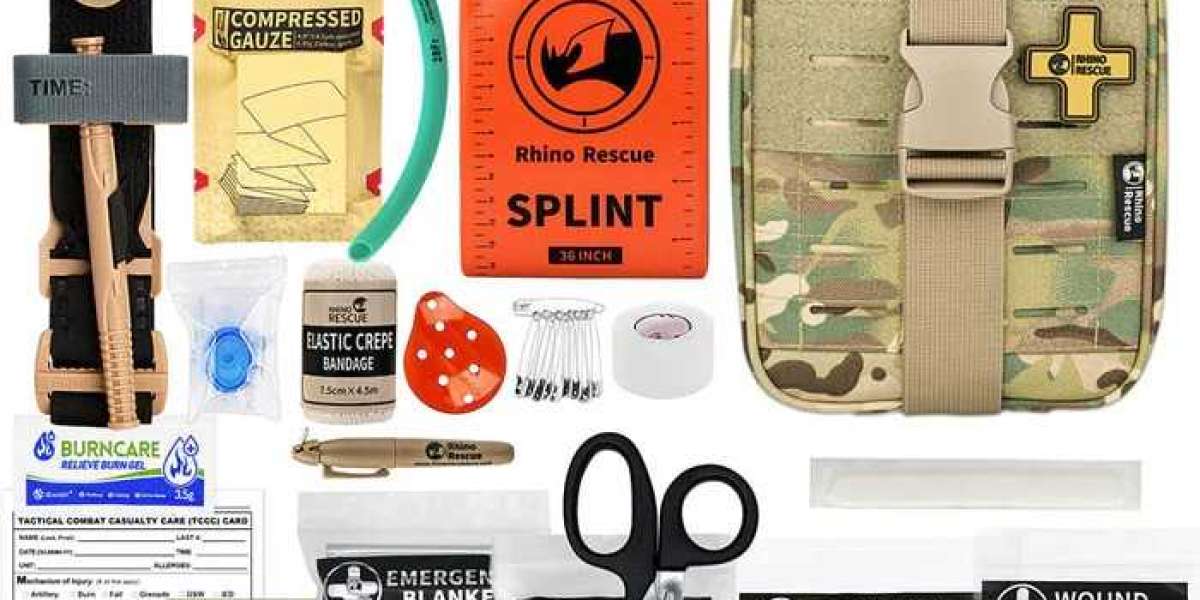When it comes to essential first-aid items, most people think of bandages, antiseptics, and gauze pads. However, one item that is increasingly recognized for its life-saving capabilities in high-risk situations is the military combat tourniquet This specialized tool is designed to control severe bleeding, particularly from limb injuries, making it indispensable for emergency scenarios where immediate help may not be available.
The Role of Tourniquets in First Aid
Tourniquets have been around for centuries, initially used as a last resort in combat settings to prevent soldiers from bleeding out on the battlefield. They’ve since become more accessible for civilian use, especially in high-risk activities like hiking, camping, and construction, where severe injuries are more likely. A tourniquet’s ability to stop life-threatening blood loss within seconds makes it a valuable tool, ensuring vital time for medical intervention.
Why a Combat Tourniquet is Superior to Traditional Methods
In emergency situations, controlling bleeding is often a top priority, as severe blood loss can lead to shock or death within minutes. Traditional methods, such as applying pressure with gauze, are sometimes ineffective for substantial injuries. Combat tourniquets, like those found in TriPeakMedic’s IFAK Trauma Kits, are designed specifically to provide sufficient pressure to completely halt blood flow, helping prevent severe complications.
The combat tourniquet stands out for several reasons:
- Quick and Effective: Unlike conventional methods, which can take time and may not completely stop bleeding, a combat tourniquet can be applied in seconds, often with just one hand.
- High-Quality Construction: Combat tourniquets are designed with durable materials that won’t tear or loosen easily, making them reliable even under challenging conditions.
- Locking Mechanism: Once applied, the tourniquet remains in place, ensuring continuous pressure without the need for constant adjustment.
Key Features of a Military Combat Tourniquet
Military combat tourniquets are built for reliability in life-and-death situations. Here are some of their key features:
Durable Strap Material: Made from high-strength nylon or similar materials, the strap is designed to withstand intense force without fraying or breaking. This ensures that the tourniquet remains secure until professional help arrives.
Windlass Rod: The windlass rod is used to tighten the tourniquet. By twisting this rod, a user can increase the pressure on the limb, halting blood flow from even the most severe injuries. The rod is often reinforced for durability.
Locking Mechanism: Once tightened, a locking mechanism holds the windlass in place, preventing it from loosening. This feature is essential for long-lasting pressure, especially during transport or when the patient must move.
One-Handed Application: In situations where only one hand is available, such as when self-applying to an injured limb, combat tourniquets offer a design that makes it possible to apply them single-handedly.
Compact Design: Combat tourniquets are often compact and lightweight, allowing them to fit comfortably in first-aid kits, tactical vests, or emergency response bags.
Time Tag: Many combat tourniquets include a space or indicator to mark the time of application. This is crucial information for medical personnel who need to know how long the tourniquet has been applied to manage treatment effectively.
Scenarios Where Combat Tourniquets Are Essential
Combat tourniquets are valuable tools in various emergency scenarios, including:
- Vehicle Accidents: In car crashes, severe injuries to limbs are common. A tourniquet can help control bleeding until paramedics arrive.
- Natural Disasters: Earthquakes, hurricanes, and other disasters can result in traumatic injuries where immediate medical response may be delayed.
- Outdoor Activities: Hiking, climbing, or other outdoor sports can lead to severe injuries far from medical facilities. Having a tourniquet on hand provides a reliable first-aid solution.
- Construction and Industrial Accidents: Heavy machinery can cause serious injuries, making combat tourniquets valuable for on-site first aid in workplaces.
Benefits of Including a Combat Tourniquet in First-Aid Kits
Adding a combat tourniquet to a first-aid kit significantly enhances preparedness for emergencies. Here are some key benefits:
Enhanced Life-Saving Potential: Severe bleeding is a primary cause of preventable death in trauma cases. A tourniquet provides a straightforward way to halt this blood loss, giving victims a better chance at survival.
Increased Preparedness: Including a combat tourniquet in your kit means being prepared for worst-case scenarios. It’s an essential tool for first responders, outdoor enthusiasts, and anyone interested in emergency readiness.
Peace of Mind: Knowing you have the tools to handle severe injuries can make a huge difference in high-risk environments. Whether you’re at work, on a hike, or traveling, having a combat tourniquet in your kit offers peace of mind.
Versatile Use: Combat tourniquets are versatile tools, useful in a variety of emergencies from road accidents to industrial injuries, making them a practical addition to any first-aid kit.
How to Use a Combat Tourniquet Correctly
Using a tourniquet correctly is essential to ensure its effectiveness and prevent potential complications. Here’s a quick guide:
- Position the Tourniquet: Place it around the limb, about 2-3 inches above the wound and not over a joint.
- Tighten the Strap: Secure the strap snugly around the limb.
- Twist the Windlass Rod: Use the windlass rod to apply pressure, tightening it until bleeding stops completely.
- Lock the Windlass: Secure the windlass in place with the locking mechanism to maintain pressure.
- Mark the Application Time: Write down the time of application, if possible, to help medical responders.
Training and Familiarity with Combat Tourniquets
While combat tourniquets are designed to be user-friendly, taking the time to familiarize yourself with the device and practicing its application can make a big difference in an emergency. Training courses in basic first aid often include instruction on how to properly use a tourniquet, allowing you to practice in a controlled environment.
Maintenance and Care
Keeping your combat tourniquet in good condition is essential to ensure it works when needed. Here are a few maintenance tips:
- Regular Inspection: Check for any signs of wear or damage to the strap, windlass, and locking mechanism.
- Proper Storage: Store the tourniquet in a cool, dry place to prevent material degradation.
- Replace After Use: Most tourniquets are single-use items, as repeated application can decrease effectiveness. Replace it after use to ensure it remains reliable.
Conclusion
A combat tourniquet is a critical addition to any first-aid kit, providing a reliable solution for severe bleeding in emergencies. Whether you’re a first responder, outdoor enthusiast, or simply preparing for unforeseen situations, having a military-grade tourniquet ensures you’re ready to respond effectively. With features like durable construction, a secure locking mechanism, and single-handed application, these tourniquets are designed to perform when it matters most.







